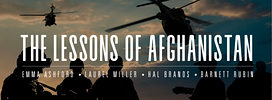I greatly appreciate the detailed responses to my initial essay from Hal Brands, Barnett Rubin, and Laurel Miller. I have found their responses enlightening and challenging to some of my own assertions and understandings of America’s longest war. At the same time, I found some of the responses frustrating, not because of the authors’ excellent points, but because twenty years after the United States invaded Afghanistan, we are in many ways still having similar arguments. A couple of common themes and disagreements emerge from the responses; rather than respond individually, it seems more useful to highlight the general distinctions between the essays, which still represent some of the key disagreements within the policy community on Afghanistan policy.
The first point requires a mea culpa on my part. In focusing my essay on the implications of the war and today’s withdrawal for U.S. policy, I neglected to mention the costs of the war to those who have suffered the most. The Afghan people have suffered mightily not just over the last two decades, but ever since the Soviet invasion of that country in 1979. As Miller puts it, “Whatever one’s view on the merits of exiting now, there should be room to spare a thought for the costs that the U.S. invasion visited on many Afghans.” She is right; the total cost of the war is not only the several thousand U.S. servicemembers and contractors who lost their lives, but an estimated 240,000 people across both Afghanistan and Pakistan. In the context of the U.S. withdrawal, policymakers need to not only include some acknowledgement of these costs—which I failed to do in my initial essay—but also to reckon with the question of how we can assist the Afghan people going forward, with aid, diplomatic assistance, and immigration benefits for those who need them. Miller argues that “the United States should spare no effort in trying to mitigate that suffering.” I wholeheartedly agree.
This suggests a further point of contention between respondents. Using an Afghan-centric lens vs. a U.S.-security perspective calls into doubt many critics’ assertions that Afghanistan, far from being a theatre of the “forever war,” was a sustainable, low-cost intervention that the United States could maintain for decades. As Hal Brands describes it, however, it becomes clear that such a model is low-cost only for the United States: he argues that Afghanistan is a “sustainable counter-terrorism model featuring airpower, special operations forces, and other unique enablers deployed in support of local forces that made the vast majority of the sacrifices.” Whether this is truly sustainable in the context of Afghan casualties is thus questionable. As Barnett Rubin points out in his response essay, nation-building in Afghanistan partly failed because the United States remained focused on counterterrorism at the cost of more inclusive political or regional solutions. As he describes, “the insurgency did not derive from opposition to liberal institutions. It derived from illiberal counter-terrorism measures, including both political exclusion and violent abuses.” The less visible costs of counterterrorism—at least from Washington—undoubtedly helped to undermine the “sustainable” U.S. military presence that Brands and some other analysts have proposed for Afghanistan—and vice versa.
A third issue that arises out of the debate is the origins of U.S. strategy in Afghanistan. As both Miller and Rubin point out, I perhaps oversimplified American motives, particularly in implying that one could separate the “good war” against the Taliban and al Qaeda from the nation-building fiasco that followed it. Indeed, as Miller points out, an intrinsic part of regime change in Afghanistan—of ousting the al Qaeda-supporting Taliban and preventing their return—was backfilling the regime in Kabul with something more acceptable to the United States. She thus argues that the two missions were inseparable, rather than a case of mission creep. But while it would have been both un-strategic and irrational to simply topple the Taliban in 2001 and walk away, there were also middle options between doing nothing and the full-throated attempt to rewrite the entirety of Afghan society and politics that the Bush administration chose. The United States could simply have installed a friendly autocrat in Kabul, as unlikely as that might have seemed given the Bush administration’s strong support for the war on terror and the “transformation of the Muslim world.” Alternately, the United States could have pursued a more broad-based coalitional approach to Afghan politics. As Rubin points out in his rebuttal, the United States probably undermined its own efforts in Afghanistan, partly through the prioritization of assertive counterterrorism, but also through what he describes as a fundamental attribution error that identified the Taliban as entirely aligned with al Qaeda and refused to allow them to participate in the political process at any point. One could easily argue that the decision to pursue broad-based democratization with liberal characteristics—and to avoid a narrower power-sharing approach to Afghan politics—was a choice, not a necessity forced upon the United States.
Finally, these excellent articles make clear that twenty years after the Afghan invasion, elites are still deeply conflicted about the conflict and its necessity for U.S. foreign policy. This contrasts rather sharply with public opinion, where a sizable majority of Americans now support withdrawal, and less than a quarter now view the war as successful. Yet every essay here also framed the U.S. campaign in Afghanistan as a retrospective, rather than an argument for continued presence. I hope that Joe Biden’s decision to finally withdraw troops from Afghanistan will thus also serve to improve the quality of Washington’s debates on the war, as we finally start to consider the conflict in retrospect, rather than an ongoing and contentious military engagement. As these essays show, a retrospective approach may ultimately help us to better understand why U.S. policymakers made the choices they did, and why we failed so badly in achieving our goals.

